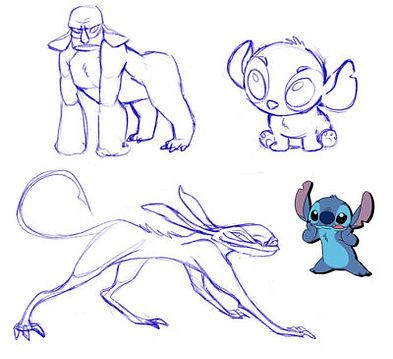Lilys digital portfolio
Shape Language
Shape Language is a concept used in art and animation to communicate meaning based on shapes we are familiar with. It involves using various geometric shapes, curves, angles, and proportions to communicate certain characteristics or moods. For example, sharp and jagged shapes can convey danger or aggression, while soft and rounded shapes can evoke a sense of comfort or playfulness. By intentionally choosing and manipulating shapes, animators can enhance storytelling and create a more visually engaging and cohesive experience for their audience.


Characters with shape language:
1. Mickey Mouse: Mickey's round head and circular ears give him a friendly and approachable appearance, emphasizing the use of circles in his design.
2. SpongeBob: SpongeBob's square shape is a key element of his character design, representing his cheerful and optimistic nature with soft edges and circular parts.
3. The Pink Panther: This character is often depicted as a sleek and stylized pink panther with a triangular-shaped head, adding to his mysterious and mischievous persona.
4. The Powerpuff Girls: Each of the Powerpuff Girls has a distinct shape language. Blossom has a circular shape, Bubbles having a rounder square shape, and Buttercup having a triangular shape, reflecting their individual personalities.
Villains with shape language:
Triangles are often used for villains because they can convey a sense of danger or unease. The sharp angles and points can be associated with aggression and instability, which fits well with villainous characters. An example of this is Maleficent from Disney's Sleeping Beauty. Her sharp, triangular horns and angular features give her an intimidating and sinister appearance. Another example is the Wicked Witch of the West from The Wizard of Oz, with her pointy hat and sharp facial features. And also the Joker from Batman, who often has a menacing grin with sharp, triangular edges. These characters use the power of shape language to visually convey their villainous nature.
Essay on Character design:
Stitch from Disney's Lilo & Stitch franchise was created by Chris Sanders. Taking a look at the character design and breaking it down, you can see that stitch is shown as a cute and fun character. This is not only because of his personality but because of his appearance, Stitch is a very circular character such as his eyes, nose and overall head shape, giving him a soft and squishy look, appearing as innocent, approachable and cute.
Stitch stands out not only because of his adorable size and personality but also because of his blue colour. His unique shade of blue resembles a vibrant turquoise or aqua blue, characterized by its bright and lively appearance that adds to his appeal and personality. Stitch was originally going to be green and yellow but they found it took away the focus on the eyes and nose. The specific blue shade of Stitch is often used to create instant recognition in marketing materials, merchandise, and fan art, helping fans easily identify the character.

Comparing this to Yzma, designed by Joe Moshier and drawn by Dale Baer from The Emperor’s New Groove you can see that her appearance is very triangular and slim so she appears as very villainous. Her exaggerated jaw, long eyelashes and thin triangular body have strong sharp angles and points which can be associated with aggression and instability but also showing intimidation and a sinister appearance.
For colour scheme Purple is a popular colour choice for portraying Disney villains due to its visual contrast, the symbolism of power and mystery, cultural references to magic, and its potential psychological impact on viewers. Purple is often associated with mystery, magic, and royalty, which can help emphasize the villain’s supernatural powers. She also has big white round eyes with sharp inner corners and small black pupils, this makes her eyes stand out because of her small, light purple face but at the same time making it blend in because of her wide grim and magenta-coloured lips.
